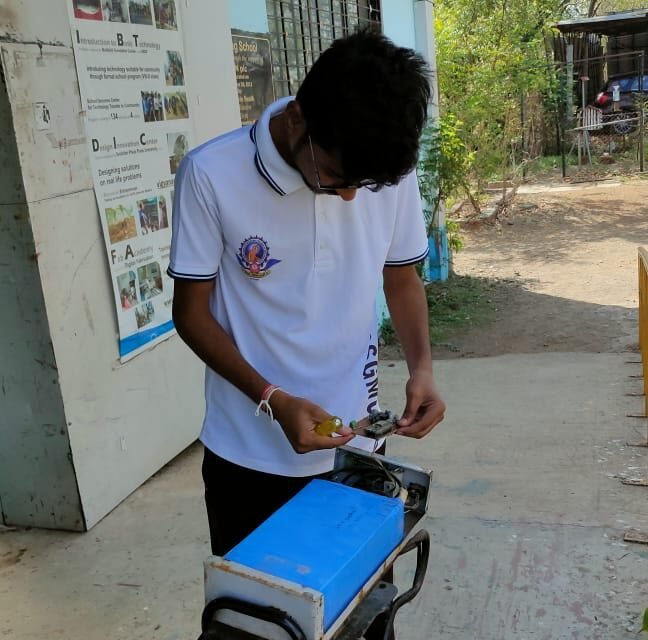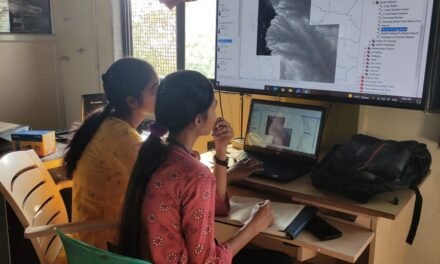Cycle No.1
Date:11/06/2023
Discussion with Dixit Sir.
Today, I had a discussion with Dr. Arun Dixit regarding various topics, including Incinerators, Heat Pumps, E-Cycles, and E-Rickshaws. Dr. Dixit shared insights about the issues faced in Incinerators, E-Cycles, and E-Rickshaws. He mentioned that they had two E-Cycles, both of which had been inactive for the past 4-5 months. One of the E-Cycles, a Hero Lectro model, used to offer a range of 100 km on a single charge about 3-4 months ago, but now it only provides a range of 10 to 15 km. As for the other E-Cycle, it was not starting, and after investigation, it was discovered that both cycles had battery-related problems.
Today, our discussion primarily focused on exploring these problems in-depth and attempting to find viable solutions for them. We studied various concepts and issues related to Incinerators, Heat Pumps, E-Cycles, and E-Rickshaws.
Date:12/06/2023
Survey and Testing of E-cycles.
Today, Vrushabh Zunjunkar and I conducted testing on cycles. We started by charging the battery of one cycle, which took one and a half hours. During this process, we observed that the charger was in good condition and functioning properly.
Next, we took the cycle for a ride, and after covering a distance of 12 km, we noticed that the battery was discharged before its expected time. This led us to conclude that there was an issue with the battery.
After discussing the matter with Vrushabh sir, he replaced the old battery with a new Li-ion Battery with the following specifications: Voltage – 24V and Current – 24Ah. He used lithium iron phosphate cells (LiFePO4) of Cell Model: IFR32700N60 and Cell Size: 32650, as they were rechargeable.
Upon conducting further testing, we confirmed that the throttle was working correctly, and there were no issues during acceleration. Additionally, we found that the charger and motor, a 250W BLDC motor, were in good working condition.
In summary, based on today’s discussion and work, we identified that the charger, motor, and throttle were all functioning properly. However, the problem lied with the old Lead Acid Battery, which was discharging prematurely. With the replacement of the battery with a new Li-ion one, we expect the issue to be resolved.
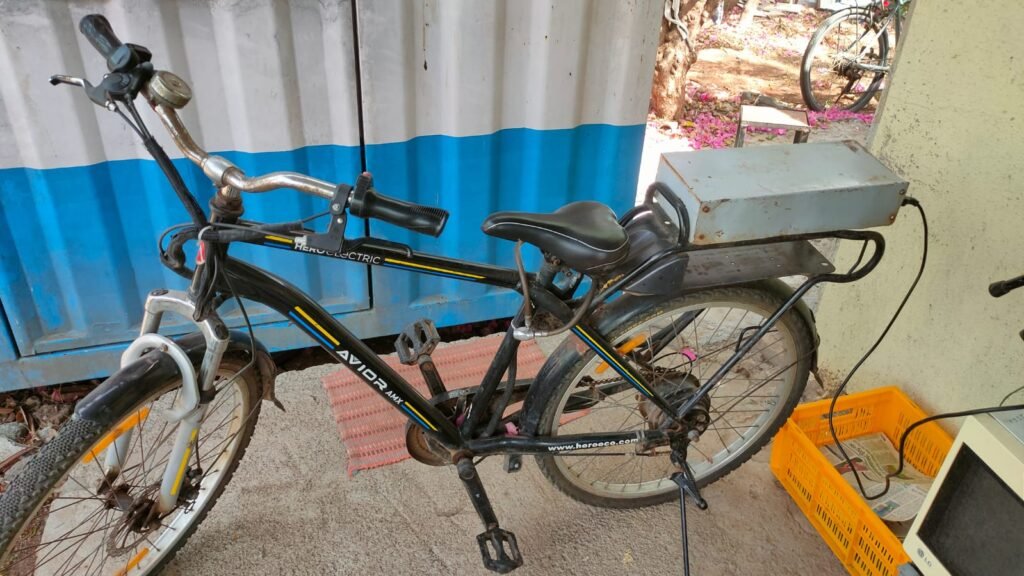
Date : 13/06/2023
Opening the batteries and Finding Problem.
Today, I decided to open the E-cycle battery, following my conclusion from the previous blog that it was not functioning properly. The battery was a lithium iron phosphate (LiFePO4) cell model IFR32700N60, with a cell size of 32650 and a voltage of 24V and a current of 24Ah.
To begin, we disconnected all the external connections and turned off the MCB (miniature circuit breaker). We then separated the connection between the motor and the battery before opening the protective cover of the battery. Inside, we found a PCB for the display of the battery percentage, but unfortunately, the display was also not working. Upon further inspection, we noticed that the battery was equipped with two Rema Battery Connector SB350, which are large connectors capable of handling up to 450 amps with 4/0 wire.
Moving on, we carefully took the battery outside and took precautionary measures by covering all the exposed wires with insulation tape to prevent any damage. With a cutter, we made precise cuts on the battery covers to access the cells without causing harm. The battery had two protective layers – an upper layer made of PVC tub and a lower layer made of FRP (Fiber-Reinforced-Polymer) sheets, ensuring both waterproofing and safety for the connections. This upper layer was common in all li-ion batteries.
After successfully opening both covers, we discovered a total of 32 cells, each with a voltage of 3.2V. The pack configuration was identified as an “8S4P pack,” meaning it had eight cells in series and four cells in parallel, resulting in the final specifications of 24V and 24Ah. The cells were connected using nickel strips, and the connections to the BMS (Battery Management System) were found to be proper.
With the help of a multimeter, I measured the voltage of each cell. Out of the 32 cells, 28 were showing a voltage of 3.35V, which seemed to be functioning correctly. However, there were 4 cells that showed a voltage of 3.27V, indicating that they were under voltage. Additionally, some of the nickel strips were loose, which I believed to be the actual problem with this battery.
I planned to address the issue by re-securing the loose nickel strips and possibly replacing the under-voltage cells to restore the battery’s functionality and efficiency

After all the discussions and surveys, I have concluded that there are 4 cells that were experiencing low voltage, and some nickel strips were loosened. This is likely the reason why the battery got discharged very early.
Battery Specifications.
In Vrushabh Zunjurkar’s blog post, a DIY lithium iron phosphate (LiFePO4) battery for an electric cycle is described. The battery pack consists of lithium iron phosphate cells with the model IFR32700N60 and a cell size of 32650.
The battery pack’s parameters are as follows:
- Voltage: 24V
- Amp-hour (A-hr): 24 A-hr
The pack configuration is designated as an “8S4P pack,” which means it consists of 8 series-connected (8S) groups of cells and 4 parallel-connected (4P) cells within each group.
Since each parallel group contains 4 cells, and there are 8 parallel groups in total, the battery pack comprises a total of 32 cells (8S * 4P = 32 cells).
The final specification of the battery pack is 24V and 24 A-hr, which is obtained by connecting the cells in this 8S4P configuration.
For more detailed information, you can refer to Vrushabh Zunjurkar’s blog post: https://vadic.vigyanashram.blog/2021/09/30/building-a-diy-lithium-iron-phosphate-lifepo4-battery-for-electric-cycle.
Date:15/06/2023
Today, I went to Pune to get the battery repaired. During the inspection, we discovered some issues with the cells and Nickel Strips. Due to the unavailability of certain facilities, we decided to take the battery to Sawant Automation in Alandi, Pune.
Initially, we had a discussion with Dixit sir and Sumit sir, and together, we concluded that instead of searching for various repairing centers, we would directly go to Alandi. This decision was based on its proximity and positive reviews. Accompanied by Dixit sir and Sumit sir, I visited the center and discussed the problems with today’s electric vehicle batteries and potential solutions. We also consulted with Sawant sir about our E rickshaw battery and informed him about the issues we were facing with our e-cycle battery.
In the end, we wrapped up the meeting, and the conclusion was that they would provide all the necessary help for our E rickshaw and promptly repair our e-cycle battery.
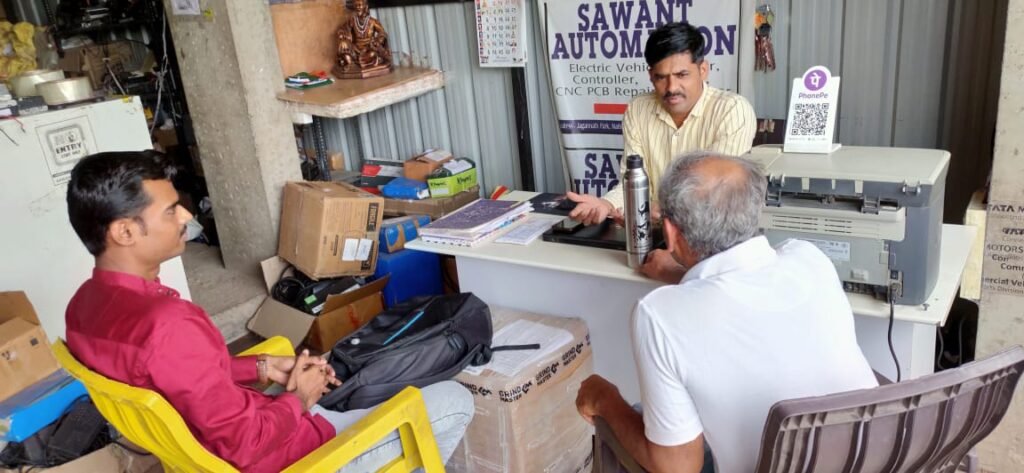
Date: 19/06/2023
Today, we brought our battery from Sawant Automation. Initially, when we checked the battery voltage there, it wasn’t showing any reading. The person in charge took the battery inside to inspect it and found that one of the connections was loose, which was why the voltage wasn’t displaying. After fixing the connection and ensuring proper wiring, the voltage showed a satisfactory reading of 24V. Later, we brought the battery to Vigyan Ashram.
Date: 20/06/2023
Today, we decided to connect the battery to the cycle and check if it was working. I connected all the wires properly and placed the battery on the cycle’s cover. I also made sure to connect the MCB (Miniature Circuit Breaker) properly. However, when I switched on the MCB, the cycle did not start. I double-checked all the connections, and they were all correct.
Next, I removed the battery and checked its voltage using a multimeter, but it did not show any voltage. Worried about the issue, I called Sawant Automation and explained everything to them. After hearing the details, Sawant suggested charging the battery. I charged the battery, and it showed that it was fully charged. Despite this, the cycle still wouldn’t start.
Given the situation, Sawant advised us to bring the battery to their service center. As a result, I decided to entrust the battery to Sawant and refrain from attempting any further actions with it.

Date:23/06/2023
solving the battery issue
Today, we brought the battery to Sawant Automation in Alandi, as mentioned in our previous blog. We had repaired the battery, but upon connecting it, the cycle did not start, and we noticed there was no voltage. Consequently, we sought assistance from Sawant Automation.
The technician at Sawant Automation checked the battery thoroughly, and upon opening it, they discovered a loose connection, which was the reason for the voltage issue. After fixing the problem, the battery started showing voltage again. The technician also advised us to handle the battery carefully to avoid any future connection problems.
With the battery now showing voltage and being in good condition, we proceeded to take it to Vigyan Ashram.
Date:24/04/2023
and repairing of all the mechanical part of battery
Today, I took my bicycle to the repair center because it had a puncture, and the brakes were not working properly. I had all the necessary repairs done at the center, including fitting a new battery and ensuring all connections were properly secured. Once everything was connected correctly, I switched on the MCB and found that the cycle was functioning perfectly. I took a test ride and confirmed that the cycle was working without any issues.
Now, the cycle is in excellent condition

On 16th July , After working properly for some time, the cycle stopped again and was not starting. This time when the battery was connected to the charger, it was showing full charge but the cycles were not happening and after checking the voltage of the battery, it was showing only 20V. When I informed Mr. Sawant about the issue, he suggested that it might be due to cell unbalancing in the battery. He advised me to bring the battery to Alandi for further examination.
On 24th July the batteries were given to Sawant Automation.
Now I handover this project to Suhas Sir and Mahesh Sir
Cycle No.2 : Hero Lectro E-cycle
Date : 16/06/2023
Opening of other cycle’s battery
As per the discussion with Ranjeet sir and Dixit sir that the hero lectro cycle was not in used from last 6 month because charger is not available. So we thought that the there was also battery issue. So I decided to open the Battery in presence of Sumit Thakare sir. Then I first overlook to all the connection of the battery , motor and throttle. Then I disconnected all the connections. Then I remove the battery from the cycle. While removing the battery from cycle we got its controller with it. Then we remove connections between the controller and battery and took out the battery. The battery is cover with the PVC tub . We found there is one Fuse of 10Amp after checking the it on multimeter fuse is in good condition. Then I check all the connection of the controller and throttle properly and I found there is one connection is cut.


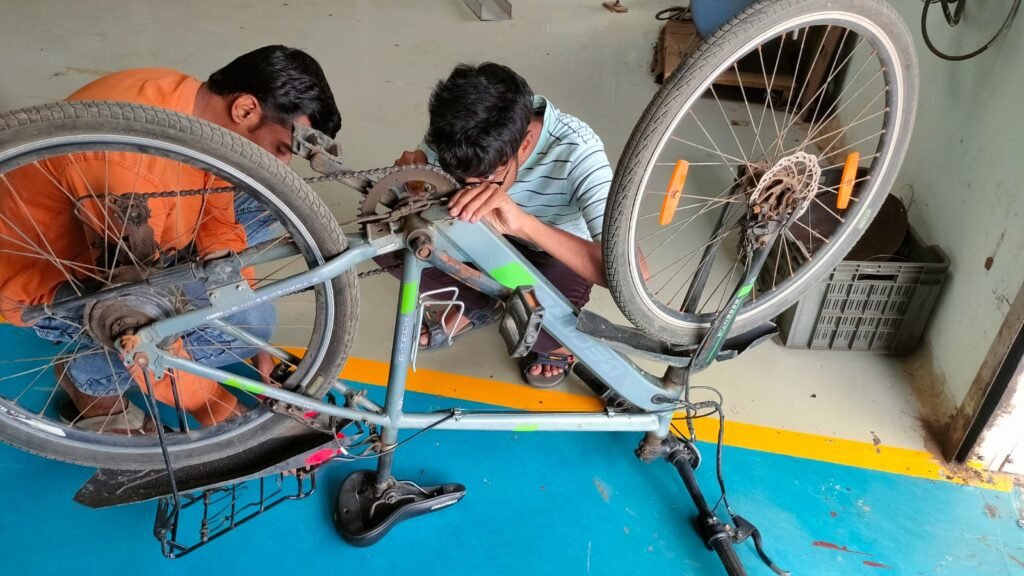
Date:17/06/2023
Opening the battery and check the cells
In last blog as I mention I took out battery from cycle. Today I opened the battery. First I cut the PVC tub layer with the help of cutter. I cut it in proper way. The pack configuration is designated as an “20S2P pack” with a final specification of 36V,5.8AH.=10*2=20 nos . This battery has li ion mh12210 Cells. And it is rechargeable battery. The voltage of each cell is 3.7V . When we checked the voltage of each cell we found that all cells in proper manner and all cell gave 3.9V. It means battery is good.
At the end we concluded that the battery is in good condition, all cells are okay and there is no issues with battery.


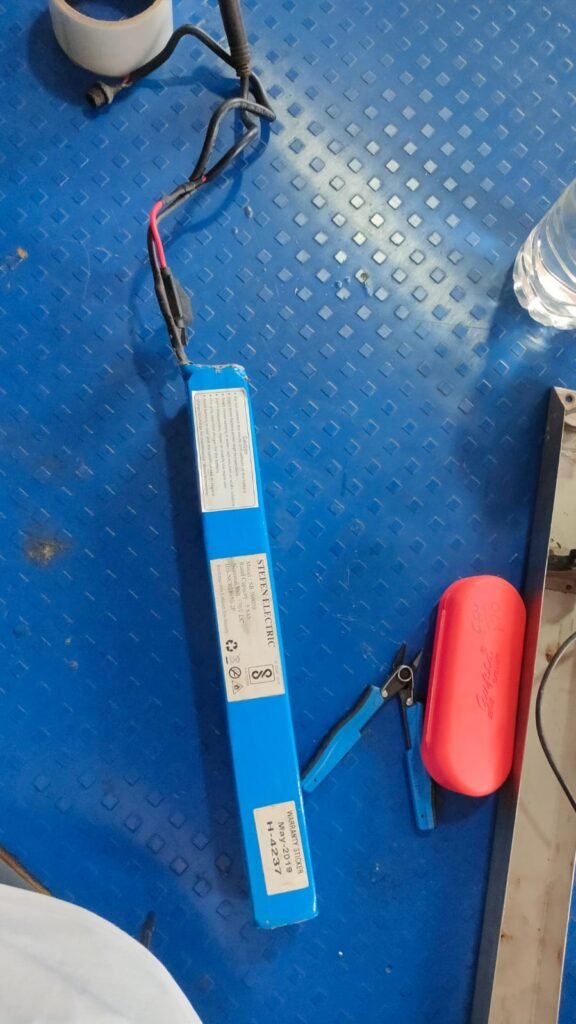

Date:18/06/2023
Checking throttle , display and controller
After our last conclusion we knew that there is no battery problem. So today we checked all other parts. First we charge the battery and it took 2 hours to charge. And we found that the charger is working good. After fully charge the battery I started the Cycle but the display is not working and the main source to the cycle is goes through the display that has On and Off button. So we found that the display of this cycle is not working. Then I open the Display and I found that some of the part is damage and that’s why display is not working.
And we then we discussed with Dixit sir and concluded that we will bring new display for this cycle.

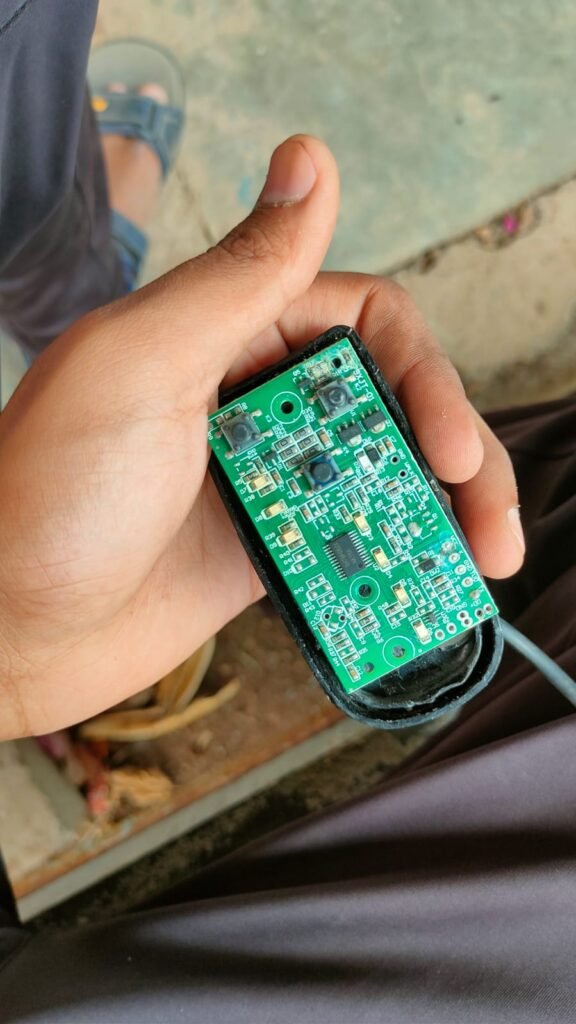

We started contacting dealers for new display we found 2 dealers one Surana Cycles and another Janata Cycles. Surana cycle dealer was selling that display for 2600. After that we asked Janta Cycles then they told us same display in 2100. But they told that it will take 3-4 days to get the display. Then we order the display on 22nd July when they had the display available and sent it to Ranjit Sir’s house by courier.
On 24th July, Ranjit Sir brought that display to the Vigyan ashram, then we decided to install that display cycle, but when we went to install the display cycle, Then I noticed that the connection from the controller to the display was broken, then I soldered it and connected it. After that I tried turning on the display and the display turned on and the cycle started running as before. For extra protection, we put a rubber sleeve on it and fitted it with a hot air gun. After that I fit the battery and controller properly and put all the connections in the cycle.
Finally the cycle started running as before and I showed it to Ranjit sir and gave the cycle to Dixit sir.

